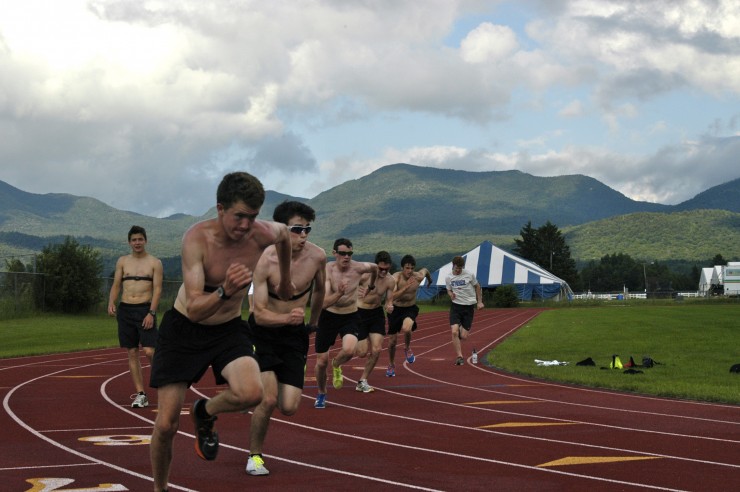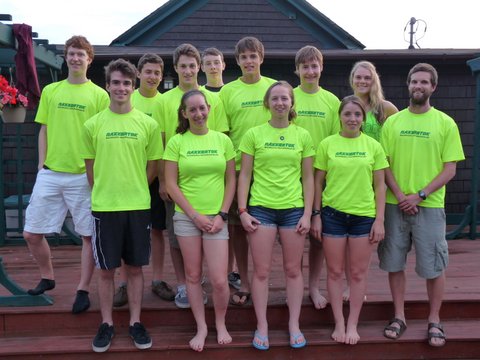
Isaac Alexander-Cook, Kyle Curry (St. Lawrence University), Cary Pomeroy, Phil Marshall, Brendon Howard, Symon Stowe, and Patrick Van Walraven.
(Photo: Jesse Williams)
Welcome to Wednesday Workout, where we provide and break down training ideas on a weekly basis. This week, Kieran Jones, head coach of the Nakkertok Ski Club in Ottawa and former FasterSkier reporter, gives some advice for developing a strong baseline and widening the range between easy and max efforts.
***
Skiers like pain. Skiers like feeling exhausted. Regardless of whether you’re a 10 year old girl, a 55-year-old master-blaster, or an Olympic champion, if you’re a skier, you love feeling the hurt.
But sometimes, to get to the hurt, you need to lay out a strong baseline. And to do that, you have to think beyond “I want to hurt.”
Nakkertok has approximately 50 athletes in the two programs I directly coach, with almost all of them falling in the 15- to 20 year-old age range. As a coach of these Junior athletes, my major goal is to expand their physical literacy to the point where there is a range beyond “slow” and “all-out.”

The Workout: Cue Level 3 Running Threshold Loops
- Easy 15-minute warmup jog, followed by dynamic warmup exercises, including 5 x 6-second acceleration sprints for range of motion
- 4 x 10 minutes on rolling terrain, with 3 minutes recovery between each rep
- Easy 15 minute cool-down jog
The major goal of the workout is to ensure that athletes are running at the correct speed and effort level. Depending on your available metrics, you can control it a number of ways. If you’re using heart rate zones based off a maximum heart rate, I recommend 82-88 percent of your max. If you’re using a lactate monitor, target lactate readings of 3-5 mmols. If you’re running based on ‘feel’, aim an 8 out of 10. Finally, if you’re running based on pure effort level, think of a pace you can sustain for around 50-60 minutes.
The first step is to mark out a clear loop over rolling terrain. I like to make the loop so that the faster athletes do a little more than 1 loop, and the slower athletes do a little less than one loop, so that whole group can start each rep together.
Generally I don’t get too bent out of shape about the number or grade of uphills, but it’s important to consider the level of runner you have. I try to avoid loops with hills I know will crush the groups’ legs on the first interval.
The greatest thing about the loop is that no matter what you have a number of metrics you can record as a coach. If you’re high-tech enough to own a lactate monitor, you can set up a lactate-test station, and take samples as people come off the loop. If your athletes have heart rate monitors, you can record max values for each rep. If you only have a stopwatch, you can record times for the loops for each athlete. Or if you have nothing but the shirt on your back, you can drop that shirt where you end on the first rep.
For pacing, emphasizing that the first rep should feel quite easy is important. If an athlete is breathing hard, or glancing at their watch every 5 seconds thinking “oh god, please let this end” on the first or second rep, chances are they are going too hard. If by the third interval they aren’t able to hit the same time or finish point, then you know they’ve gone out of the gate too fast.
If you’re measuring heart rates, I like to see a consistent increase without a huge jump or drop off. For example, recording a max heart rate at the end of each interval, I want to see the following: Rep 1: 165, Rep 2: 170, Rep 3: 172, Rep 4: 174.
The above athlete will finish the workout without collapsing on the ground due to the feeling of “concrete block” legs, be able to do an easy cool down, have a nap, and be ready to roll again by 3 PM for the afternoon workout.
The part B of this workout is something athletes love. We often return to the same spot six or eight weeks later, and repeat the workout. The athletes have recorded the time or distance they were able to travel the first time, and then are able to see themselves beat that mark working at a lower effort level or heart rate. As the workout is running, you remove the variable of rollerski speed, broken pole tips, or traffic that can often throw off data collection in a rollerski workout. Not all athletes can make it to World Juniors, or win a medal at Canadian Nationals – but all athletes want to see that the work they are doing is resulting in improvement.
My favourite part about this workout is that it forces athletes to think about controlling their speed and effort. If you’re a highly motivated skier (see: every skier ever) it’s quite easy to go out and hammer at your max. But it’s harder to rein yourself in, and work in the right range.



